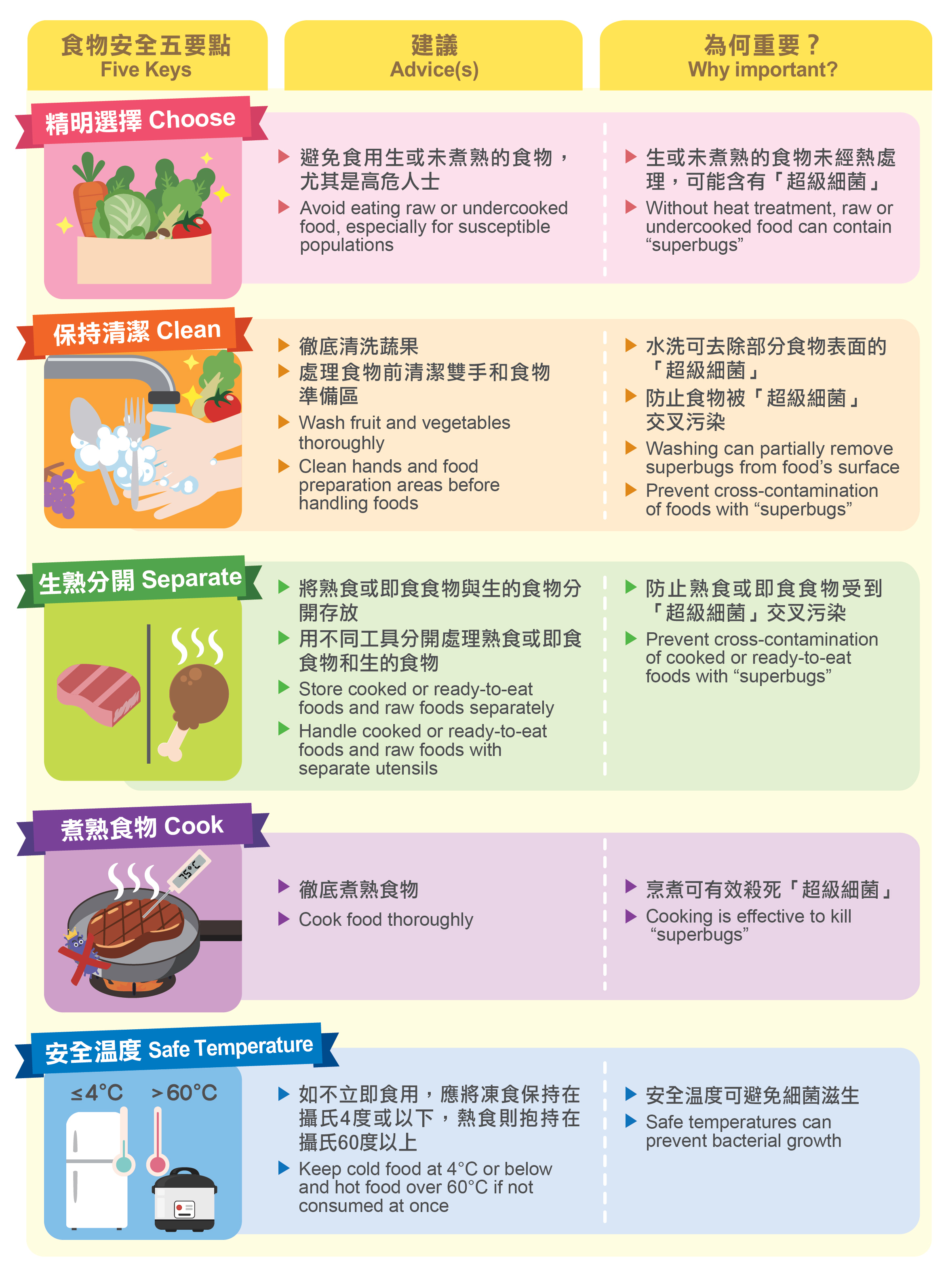
Food Safety Focus (201th Issue, April 2023)–Article 2
“Superbugs” in Foods
Reported by Dr. Ken CHONG, Scientific Officer,
Risk Assessment Section, Centre for Food Safety
Antimicrobial resistance (AMR) is a threat to global health that necessitates quick cross-sectoral responses, including those from people involved in the food industry because food, especially food animals, can be sources of and vehicles for the spread of AMR microorganisms. The rapid spread of multidrug-resistant bacteria, or “superbugs”, which cause infections with few or no available antimicrobials for treatment, is of special concern. In this article, we will discuss the finding of “superbugs” in food, as well as what we can do to lower the risk of contracting them.
Monitoring and Surveillance of “Superbugs” in Food
People can be exposed to AMR microorganisms through a variety of sources, including other people, contaminated food, water, animals, and the environment. Under the One Health Approach, thanks to an integrated monitoring and surveillance system, data comparison across sectors and comprehensive analyses to ascertain the contribution of various sources to the actual burden of AMR in human diseases is possible, which can support evidence- based measures.
For food safety components, the system covers foodborne AMR, which includes collection of data for risk analysis, as well as trend analysis, epidemiological studies, food source attribution studies, and research. In general, the detection of AMR microorganisms would not be handled in the way as the detection of pathogens in food poisoning cases, but more in the way of collating data for analysis of the whole picture followed by taking proportional risk management action. In addition, it is important to determine if there is a change in AMR among human infections in response to change in foodborne AMR, under the integrated system. Such information is important for the formulation of a strategy to tackle AMR.
To determine the state of foodborne AMR, food samples are gathered and analysed for bacteria, both pathogenic and commensal. A more sensitive method is also used to identify “superbugs”, which are infrequently discovered by random sampling. This is accomplished by using a particular antibiotic to screen collected samples for designated “superbugs”; other bacteria, but not “superbugs”, will be killed by the antibiotic. As a result, even though they are present in very low amounts, targeted “superbugs” like extended-spectrum b-lactamase (ESBL)-producing and carbapenem-resistant Enterobacteriaceae can be detected. ESBLs confer resistance to critically important antimicrobial drugs and bacteria carrying the resistance trait must be treated with antibiotics of last resort, like carbapenem antibiotics. Yet, resistance to carbapenem is on the rise too. As such, it is important to keep an eye on the trends of these “superbugs”, for example, increase in the prevalence of specific strains or the genes of resistant traits.
Risk of “Superbugs” in Ready-to-eat Foods
To track foodborne AMR near the end of the food chain, ready-to-eat foods can be collected apart from animal products. The risk of ready-to-eat foods found with “superbugs” depends on whether they are foodborne pathogens, i.e. causing disease through the consumption of food. For “superbugs” that are foodborne pathogens, symptoms of infections will be similar to those caused by pathogens that can be killed or inhibited by antibiotics, while the infections can be difficult to treat in serious cases. On the other hand, no matter if the “superbug” found is pathogenic or not, there could be the possibility of the spread of AMR genes to other bacteria in the human gut. However, determining how frequently it occurs is difficult because gene transfer is a random occurrence and bacteria do not always stay in the body. There is currently no conclusive evidence that long-term consumption of food contaminated with “superbugs” results in an increased range of AMR in a person. That said, exposure to AMR microorganisms should be minimised, particularly by vulnerable populations who are more susceptible to foodborne infections.
What Can I Do to Avoid “Superbugs” in Food?
The rise in foodborne AMR would undoubtedly raise the risk of contracting AMR bacteria, but we do not act by determining whether or not bacteria are resistant. The contamination of food may occur from farm to fork as AMR microorganisms exist in the environment like foodborne pathogens. To reduce the risk of contracting both “superbugs” and foodborne pathogens, we can adhere to the 5 Keys to Food Safety in our everyday lives. On the other hand, susceptible populations such as pregnant women, infants and young children, the elderly and people with weakened immunity (i.e. people with chronic diseases or those on antibiotics treatment, antacid and long-term steroids or drugs given to prevent transplant rejection, etc.) are of higher risk and should therefore avoid eating raw and undercooked ready-to-eat foods that have no sufficient cooking to kill “superbugs” and foodborne pathogens. prepared.

Figure 2: Combating “superbugs” with 5 Keys to Food Safety

